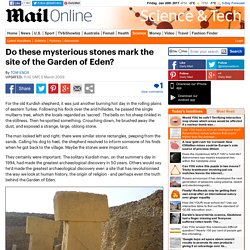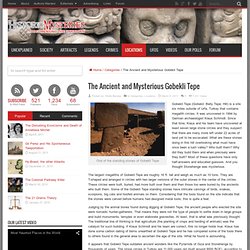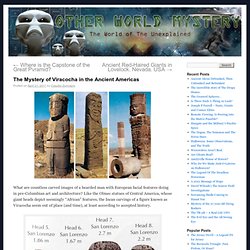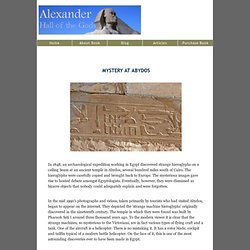

70 metal books found in Jordan cave could change our view of Biblical history. By Fiona Macrae Updated: 19:36 GMT, 30 March 2011 For scholars of faith and history, it is a treasure trove too precious for price.

Ancient Civilizations. Histoire mysterieuse disparue. Agartha. The Ajanta Caves – Ancient Temples Carved from Rock. Two thousand two hundred years ago work began on an extensive series of cave monuments in Maharashtra, India.

Over a period of hundreds of years, thirty one monuments were hewn piece by piece from the rock face. Then, some speculate around the year 1000AD, they fell in to disuse. Dense jungle grew around, hiding the caves away from human eyes. They Ajanta caves lay undisturbed for hundreds of years. Do these mysterious stones mark the site of the Garden of Eden? By Tom Knox Updated: 11:10 GMT, 5 March 2009 For the old Kurdish shepherd, it was just another burning hot day in the rolling plains of eastern Turkey.

Following his flock over the arid hillsides, he passed the single mulberry tree, which the locals regarded as 'sacred'. The bells on his sheep tinkled in the stillness. Then he spotted something. The man looked left and right: there were similar stone rectangles, peeping from the sands. They certainly were important. Top 10 Lesser Known Mysteries. Mysteries It was Einstein that said ‘The most beautiful thing we can experience is the mysterious.

It is the source of all true art and all science. He to whom this emotion is a stranger, who can no longer pause to wonder and stand rapt in awe, is as good as dead: his eyes are closed.’ For me, mystery is the fabric of Life, and since I discovered Listverse a few years ago I have noticed it’s a sentiment many people share. The Ancient and Mysterious Gobekli Tepe. One of the standing stones of Gobekli Tepe Gobekli Tepe (Gobekli: Belly Tepe: Hill) is a site six miles outside of Urfa, Turkey that contains megalith circles.

It was uncovered in 1994 by German archaeologist Klaus Schmidt. Since that time, Klaus and his team have uncovered at least seven large stone circles and they suspect that there are many more left under 22 acres of land yet to be excavated. What are these stones doing in this hill overlooking what must have once been a lush valley? Who built them? The largest megaliths of Gobekli Tepe are roughly 16 ft. tall and weigh as much as 10 tons. Gallery of mystery. Part 2 Peru bronze wheels, described by professor Rafael Larco Hoyle in his work "Peru"; they resemble very much modern gears. The famous "Kiev astronaut": it's the only European little statue found until now which shows so evident "spatial" features. Two prehistoric Japanese little statues: they represent creatures who wear special space-suits and big helmets joined to the space-suit by a sort of bolt collar. 12,000 Years Old Unexplained Structure.
The Mystery of Viracocha in the Ancient Americas. What are countless carved images of a bearded man with European facial features doing in pre-Columbian art and architecture?

Like the Olmec statues of Central America, whose giant heads depict seemingly “African” features, the Incan carvings of a figure known as Viracocha seem out of place (and time), at least according to accepted history. The Olmec Heads History teaches us that Columbus “discovered” the New World, and that the subsequent explorers and conquistadors were the first “white” men to visit the Americas. If so, how do they explain the presence of far-older carvings and inscriptions of non-native humans? To explore the mystery of Viracocha, we will analyze these puzzling artifacts, drawing from the Incan legends and the monuments themselves, while also comparing Viracocha to other pre-Columbian figures who display striking similarities.
The Mysterious Tarim Mummies. Hidden behind the Himalaya and Karakoram mountain ranges and nestled between the Kunlun and Tien Shan ranges is the vast Tarim Basin, one of the hottest, driest deserts in the world.

Yet it is here that one of the most outstanding anthropological finds of the 20th century was discovered. Over the past several years, Chinese archaeologists have dug up 100 or so Caucasiod mummies from the parched sands of the Täklimakan desert. The bodies date to between 2000 BC and 300 BC. The Stairway to Heaven. Mystery at Abydos - Hall of Gods. In 1848, an archaeological expedition working in Egypt discovered strange hieroglyphs on a ceiling beam at an ancient temple in Abydos, several hundred miles south of Cairo.

The hieroglyphs were carefully copied and brought back to Europe. The mysterious images gave rise to heated debate amongst Egyptologists. Eventually, however, they were dismissed as bizarre objects that nobody could adequately explain and were forgotten. In the mid 1990's photographs and videos, taken primarily by tourists who had visited Abydos, began to appear on the internet. They depicted the 'strange machine hieroglyphs' originally discovered in the nineteenth century. Not surprisingly, perhaps, the ancient high-tech machinery glyphs have been dismissed out of hand by modern Egyptologists. Re-carving of inscriptions was a common phenomenon in ancient Egypt. Recently, the respected Arab newspaper 'Al-Sharq Al-Awsat' published several photographs taken at another Egyptian temple, the Amon Ra Temple in Karnak.